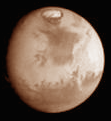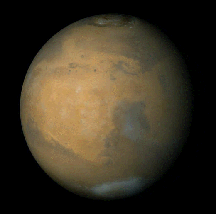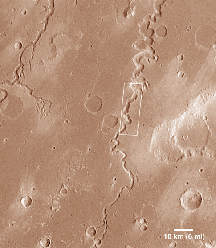free
issue
back
issues
subscribe
Athena Review Vol.2, no.2
Then and Now: On the surface of Mars
 Early Views
of Mars: While Mars had been identified as a planet (wandering body)
by the ancient Greeks, the 17th century Dutch astronomer Christiaan Huygens
was the first to study Mars through a telescope. In 1659 he identified white
spots at the poles of the otherwise orange-red globe, which he correctly
identified as polar ice caps. These are now an intensive focus of study by
NASA.
Early Views
of Mars: While Mars had been identified as a planet (wandering body)
by the ancient Greeks, the 17th century Dutch astronomer Christiaan Huygens
was the first to study Mars through a telescope. In 1659 he identified white
spots at the poles of the otherwise orange-red globe, which he correctly
identified as polar ice caps. These are now an intensive focus of study by
NASA.
[Fig.1: Mars with north pole from the Hubble space telescope in 1997
(NASA/JPL/Caltech).]
The Italian astronomer Giovanni Schiaparelli, working with much larger and
better telescopes between 1877 and 1890, saw blue-green patches on the surface
of Mars. These he (incorrectly) thought to be seas which seemed to grow and
shrink with the seasons, as if filled by the melting of polar ice. He also
noted faint lines across the surface which he called canali, or channels,
perhaps of natural origin.
 The American
Percival Lowell soon began to refer to the canali not as channels
but as canals, possibly man-made. Lowell commenced serious study of Mars
in 1894 through an 18 inch telescope near Flagstaff Arizona (now Lowell
Observatory). He reasoned that the blue-green regions observed by Schiaparelli
could not be seas because the canals, which themselves appeared to wax and
wane with the seasons, in many cases flowed straight across the
“seas.” As viewed from the Earth, however, these canals would be
implausibly wide. He therefore proposed that the canals were actually belts
of vegetation growing along waterways, much as trees grow along rivers on
Earth. This interpretation spurred the belief that Mars was a dying planet
and the canals were a last attempt by its inhabitants to concentrate their
remaining resources, a scenario like many a science fiction story including
War of the Worlds by H.G. Wells (1895).
The American
Percival Lowell soon began to refer to the canali not as channels
but as canals, possibly man-made. Lowell commenced serious study of Mars
in 1894 through an 18 inch telescope near Flagstaff Arizona (now Lowell
Observatory). He reasoned that the blue-green regions observed by Schiaparelli
could not be seas because the canals, which themselves appeared to wax and
wane with the seasons, in many cases flowed straight across the
“seas.” As viewed from the Earth, however, these canals would be
implausibly wide. He therefore proposed that the canals were actually belts
of vegetation growing along waterways, much as trees grow along rivers on
Earth. This interpretation spurred the belief that Mars was a dying planet
and the canals were a last attempt by its inhabitants to concentrate their
remaining resources, a scenario like many a science fiction story including
War of the Worlds by H.G. Wells (1895).
Fig.2 Mars from the Global Surveyor, 1997. The dark area at right
center is Syrtis Major, with clouds to the south (NASA/JPL/Caltech; Malin
Scientific Systems).]
Lowell published Mars and its Canals in 1906, promoting his view that
the canals of Mars were constructed by some highly advanced civilization.
Lowell’s work received criticism from scientists such as Alfred Russel
Wallace, codeveloper of the theory of natural selection. Ultimately, however
(as noted by Carl Sagan, premier chronicler of Mars exploration), Lowell
inspired many of his day. Besides Wells, the writer Edgar Rice Burroughs
(also the creator of Tarzan) helped popularize the idea of life on Mars with
a series of adventure books on the travels of Virginia gentleman John Carter,
among Martians who resembled barbarian warriors and beautiful princesses.
 Mars in
the Space Program: Reality began to creep in after early spectroscopic
scans of Mars in the 1940s and 50s showed its atmospheric pressure to be
perhaps one-tenth that of the Earth, barely sufficient for liquid water.
In July 1965 (after one US and six USSR failed missions), Mariner 4 made
the first successful flyby of Mars, returning 22 photographs showing cratered
plains like the Moon, but no evidence of the canals. It scanned a CO2 atmosphere
with 5-10 mbar pressure, too low to support liquid water. In 1969 Mariners
6 and 7 confirmed the low atmospheric pressure of Mars, took over 200 pictures
each, and showed virtually no water in ice caps seen as mainly frozen carbon
dioxide.
Mars in
the Space Program: Reality began to creep in after early spectroscopic
scans of Mars in the 1940s and 50s showed its atmospheric pressure to be
perhaps one-tenth that of the Earth, barely sufficient for liquid water.
In July 1965 (after one US and six USSR failed missions), Mariner 4 made
the first successful flyby of Mars, returning 22 photographs showing cratered
plains like the Moon, but no evidence of the canals. It scanned a CO2 atmosphere
with 5-10 mbar pressure, too low to support liquid water. In 1969 Mariners
6 and 7 confirmed the low atmospheric pressure of Mars, took over 200 pictures
each, and showed virtually no water in ice caps seen as mainly frozen carbon
dioxide.
In December 1971, the Soviet Mars 3 mission made the first successful soft
landing on Mars, a week after Mars 2 had crashed. While the Mars 3 lander
relayed only 20 seconds of video data before contact was lost, both orbiters
returned atmospheric and temperature data through 1972.
[Fig.3: The giant Martian volcano Olympus Mons, 15 miles high
(NASA/JPL/Caltech; Malin Scientific Systems).]
Meanwhile, US Mariner 9 reached Mars orbit Nov. 1971 during a huge duststorm.
When the air cleared, its cameras revealed a much more complex planetary
history. A huge volcanic range with giant caldera lay in the Tharsis region,
with several of the largest known peaks in the solar system, including Mt.
Olympus (fig.3), each dwarfing Mt. Everest. Such active interior geology
could produce the molecules needed for life (including water). Importantly,
Mariner 9’s images showed water had probably once flowed across the
Martian surface in river-like channels. This provided a major research incentive
for the Viking experiments and all later missions.
 [Fig.4:
Viking image of two large channels in the Xanthe Terra region; inset
shows fig.5 (NASA/JPL/Caltech; Viking).]
[Fig.4:
Viking image of two large channels in the Xanthe Terra region; inset
shows fig.5 (NASA/JPL/Caltech; Viking).]
The US Viking 1 and 2 missions, two lander-orbiter pairs designed to test
for life on Mars, each landed successfully in 1976 (year of the US Bicentennial)
amid ancient channels in Chryse and Utopia Planitia. The world watched as
Viking 1 returned its first video stills of a cobble-strewn, arid red plain
much resembling northern Arizona near the Lowell Observatory, or Death Valley.
While Carl Sagan and colleagues joked about who would be the first to see
a prospector on muleback, the robot
 Viking landers
proceeded to take soil samples and performed three complex biochemical tests.
These included a probe for organic molecules (with virtually none found),
a radioactive, labeled release experiment (giving some ambiguous results),
and a gas exchange experiment with anomalous findings later attributed not
to life, but to highly oxidized clays on Mars. Until 1980 both orbiters
documented the red planet’s surface with over 100,000 photos used to
plan return trips by Pathfinder and Surveyor.
Viking landers
proceeded to take soil samples and performed three complex biochemical tests.
These included a probe for organic molecules (with virtually none found),
a radioactive, labeled release experiment (giving some ambiguous results),
and a gas exchange experiment with anomalous findings later attributed not
to life, but to highly oxidized clays on Mars. Until 1980 both orbiters
documented the red planet’s surface with over 100,000 photos used to
plan return trips by Pathfinder and Surveyor.
The 1993 loss of contact with NASA’s Mars Observer craft was forgotten
by 1997 amid a very successful landing by the Mars Pathfinder mission, whose
small, economical lander and tiny Sojourner rover jointly returned 16,550
images of rocky surface in Ares Valles, plus data from 15 chemical analyses
of rocks, and wind and weather readings. The Global Surveyor orbiter, meanwhile,
has returned detailed photos of Mars topography for two years, testing,
confirming, or refuting theories that grew from Mariner and Viking imagery,
from river channels and sedimentation (confirmed) to “the face of
Mars” (not confirmed). Fig.5 shows a portion of the meandering canyons
of the Nanedi Valles system, a valley about 2.5 km cutting across plains
of the Xanthe Terra regionfirst imaged by Viking (fig.4). In the upper right
corner is preserved a small, 200 m-wide channel (elsewhere, covered by dunes
and debris) that indicates water must have flowed through this system for
an extended period of time.
[Fig.5: Channels of Nanedi Valles system in the Xanthe Terra region,
imaged recently by the Mars Global Surveyor (NASA/JPL/Caltech; MOC
image 8704, Malin Space Systems).]
Mars Exploration, Present and Future: Many Earthlings feel nothing
but awe for NASA’s skills of telemetry to land robots softly on the
Moon and Mars, or to send craft a billion miles to precisely circle and image
the icy moons of Neptune. It thus seems ironic that the Mars Climate Orbiter,
after a perfect liftoff from Canaveral in 1998, should crash into Mars on
Sept. 23, 1999 because somebody forgot to use the metric system in calculating
final orbital insertion, and nobody at NASA/JPL bothered to check (thus voiding
$125 million, and beefing up “Murphy’s Law”). The related
Mars Polar lander, launched January 1999 to search
for water near the South Pole (341 years after Huygens first identified it
in a small telescope) was also lost during landing in December, 1999.
The 2000 Mars Odyssey Probe,
however, achieved Mars orbit, and has now (Feb. 2003) returned important
data showing recent water release due to melting snow in small channels at
a crater's edge. Mars Exploration Rovers, scheduled for launch in May and
June, 2003 will test such areas, as scientific interest in the geology and
water environments of the red planet remain at a high level.
[For more information on NASA and JPL/Caltech, see
http://www.jpl.nasa.gov ]
Athena
Review Image Archive™ |
Guide to Archaeology on
the Internet |
free trial issue |
subscribe |
back
issues
Main
index of Athena Review |
Subject Index
| Travel
Pages |
Galleries and
Museums |
Ad
rates |
Current
issue index
Copyright ©
1996-2003
Athena Publications,
Inc. (All Rights Reserved).
 Early Views
of Mars: While Mars had been identified as a planet (wandering body)
by the ancient Greeks, the 17th century Dutch astronomer Christiaan Huygens
was the first to study Mars through a telescope. In 1659 he identified white
spots at the poles of the otherwise orange-red globe, which he correctly
identified as polar ice caps. These are now an intensive focus of study by
NASA.
Early Views
of Mars: While Mars had been identified as a planet (wandering body)
by the ancient Greeks, the 17th century Dutch astronomer Christiaan Huygens
was the first to study Mars through a telescope. In 1659 he identified white
spots at the poles of the otherwise orange-red globe, which he correctly
identified as polar ice caps. These are now an intensive focus of study by
NASA.
 The American
Percival Lowell soon began to refer to the canali not as channels
but as canals, possibly man-made. Lowell commenced serious study of Mars
in 1894 through an 18 inch telescope near Flagstaff Arizona (now Lowell
Observatory). He reasoned that the blue-green regions observed by Schiaparelli
could not be seas because the canals, which themselves appeared to wax and
wane with the seasons, in many cases flowed straight across the
“seas.” As viewed from the Earth, however, these canals would be
implausibly wide. He therefore proposed that the canals were actually belts
of vegetation growing along waterways, much as trees grow along rivers on
Earth. This interpretation spurred the belief that Mars was a dying planet
and the canals were a last attempt by its inhabitants to concentrate their
remaining resources, a scenario like many a science fiction story including
War of the Worlds by H.G. Wells (1895).
The American
Percival Lowell soon began to refer to the canali not as channels
but as canals, possibly man-made. Lowell commenced serious study of Mars
in 1894 through an 18 inch telescope near Flagstaff Arizona (now Lowell
Observatory). He reasoned that the blue-green regions observed by Schiaparelli
could not be seas because the canals, which themselves appeared to wax and
wane with the seasons, in many cases flowed straight across the
“seas.” As viewed from the Earth, however, these canals would be
implausibly wide. He therefore proposed that the canals were actually belts
of vegetation growing along waterways, much as trees grow along rivers on
Earth. This interpretation spurred the belief that Mars was a dying planet
and the canals were a last attempt by its inhabitants to concentrate their
remaining resources, a scenario like many a science fiction story including
War of the Worlds by H.G. Wells (1895).
 Mars in
the Space Program: Reality began to creep in after early spectroscopic
scans of Mars in the 1940s and 50s showed its atmospheric pressure to be
perhaps one-tenth that of the Earth, barely sufficient for liquid water.
In July 1965 (after one US and six USSR failed missions), Mariner 4 made
the first successful flyby of Mars, returning 22 photographs showing cratered
plains like the Moon, but no evidence of the canals. It scanned a CO2 atmosphere
with 5-10 mbar pressure, too low to support liquid water. In 1969 Mariners
6 and 7 confirmed the low atmospheric pressure of Mars, took over 200 pictures
each, and showed virtually no water in ice caps seen as mainly frozen carbon
dioxide.
Mars in
the Space Program: Reality began to creep in after early spectroscopic
scans of Mars in the 1940s and 50s showed its atmospheric pressure to be
perhaps one-tenth that of the Earth, barely sufficient for liquid water.
In July 1965 (after one US and six USSR failed missions), Mariner 4 made
the first successful flyby of Mars, returning 22 photographs showing cratered
plains like the Moon, but no evidence of the canals. It scanned a CO2 atmosphere
with 5-10 mbar pressure, too low to support liquid water. In 1969 Mariners
6 and 7 confirmed the low atmospheric pressure of Mars, took over 200 pictures
each, and showed virtually no water in ice caps seen as mainly frozen carbon
dioxide.
 [Fig.4:
Viking image of two large channels in the Xanthe Terra region; inset
shows fig.5 (NASA/JPL/Caltech; Viking).]
[Fig.4:
Viking image of two large channels in the Xanthe Terra region; inset
shows fig.5 (NASA/JPL/Caltech; Viking).]
 Viking landers
proceeded to take soil samples and performed three complex biochemical tests.
These included a probe for organic molecules (with virtually none found),
a radioactive, labeled release experiment (giving some ambiguous results),
and a gas exchange experiment with anomalous findings later attributed not
to life, but to highly oxidized clays on Mars. Until 1980 both orbiters
documented the red planet’s surface with over 100,000 photos used to
plan return trips by Pathfinder and Surveyor.
Viking landers
proceeded to take soil samples and performed three complex biochemical tests.
These included a probe for organic molecules (with virtually none found),
a radioactive, labeled release experiment (giving some ambiguous results),
and a gas exchange experiment with anomalous findings later attributed not
to life, but to highly oxidized clays on Mars. Until 1980 both orbiters
documented the red planet’s surface with over 100,000 photos used to
plan return trips by Pathfinder and Surveyor.